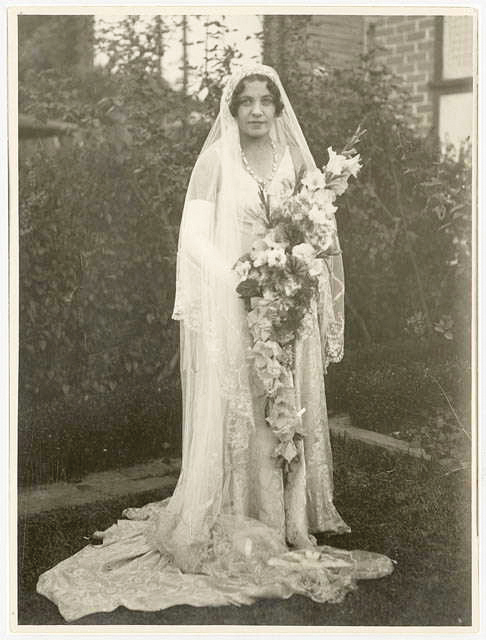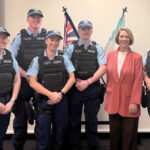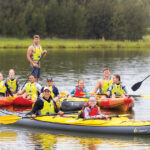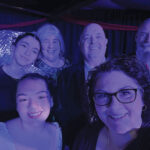By Lyn Forde – President/Research Officer of St Marys & District Historical Society Inc.
THOMAS David Beyer (Jnr) was an Anglican clergyman and Air Force Chaplain who was born in March 1906 at Lakes Entrance in Victoria. The son of Thomas David Beyer (Snr) and his wife Victoria Ruth (Dunk). His father was a well-known Gippsland personality who died suddenly in Melbourne in 1940 where he had lived for five years. Before that he was a resident of Lakes Entrance and at one time was a prominent playing member of Essendon Town football team. Later he played with distinction in the Bairnsdale and Lakes Entrance teams. He was actively associated with many civic projects for the progress of the Gippsland Lakes as a tourist resort and earned the esteem and affection of the residents of Lakes Entrance. He was also a prominent member of the Essendon A.N.A lodge and Anglers’ Society and also served for many years as a Vestryman of St Nicholas’s Church of England at Lakes Entrance and was also a member of the Synod of the diocese of Gippsland. Thomas (Jnr) attended Melbourne and Bairnsdale high schools and after finishing school he worked as a motorcar salesman in Melbourne in 1931. The next year he entered Ridley College (Australian College of Theology) and was made Deacon in December of that year. He was ordained Priest a year later for the Diocese of Gippsland and served his Curacy at Paynesville and was the “Priest-in-Charge” at Drouin in 1934. That same year in April at the Church of St John the Baptist at Bairnsdale he married Hazel Vera Johnston the daughter of Samuel Renwick Johnston and Vera Jeanette Coverdale. The ceremony was published in the Gippsland Times saying, “A wedding that created a great deal of interest was that of the Reverend Thomas David Beyer, eldest son of Mr T D Beyer, “Normanhurst” Gippsland Lakes and the late Mrs Beyer to Hazel Vera only daughter of Mrs S R Johnston, of “Carlowrie” Bairnsdale and the late Mr Johnston of Lindenow and celebrated by the Bishop of Gippsland (Dr G H Cranswick) at St John’s Church of England, Bairnsdale. The bride was given away by her brother Mr E Johnston of Lindenow and wore a beautiful gown of silver brocade from a low hipline that terminated at the unusual moulded bodice. The skirt fell in graceful folds and formed a tiny train. Very quaint sleeves of fine silver needle run lace and an exquisite veil of tulle edged with fine lace and beautifully embroidered and all hand-made was also worn. This was loaned by the bride’s cousin Mrs D Travers-Fardon, of Malvern and was last worn by Mrs Don Bradman. The bride carried a beautiful shower sheaf of white roses, cactus dahlias and sweet peas with streamers. The bridesmaids were Miss Rosalyn Langdon and Miss Jean Wyndham who were friends of the bride. They both wore frocks in tea rose pink georgette with moulded bodices and a skirt of small frills forming a short train, sleeves of dainty frills and hats of silver ribbon with tulle brims. The gloves were of frilled georgette with pink satin shoes on their feet. They both carried muffs of blue delphiniums and pink carnations with frills of pink tulle. The bride’s mother wore a Wedgewood blue wool de-Chene frock with grey fur trim and a hat to match and she carried a bouquet of red cactus dahlias and fern. Mrs Beyer the stepmother of the bridegroom was becomingly attired in a gown of brown crepe de Chene frock with orange trimmings and wore a hat to match with brown shoes and gloves. The bride and groom’s future home was at the Vicarage, Drouin.” In 1935 Thomas became Rector of Morwell where he contributed columns to the local newspaper under the pseudonym “Inquisitas”. He played cricket and Australian Rules football and participated in amateur theatricals. During WW2 in November 1940, he joined the Royal Australian Air Force as Chaplain 3rd class and was posted to Laverton, then in December 1941 to Geraldton in Western Australia. He embarked for England in January 1943, travelling on escort duty via North America and served for the remainder of the war at the No.11 Personnel Dispatch and Reception Centre that was located at Bournemouth and later moved to Brighton. This unit received RAAF personnel on arrival in England for further training or operational duties. As sole Unit Chaplain Thomas wrote hundreds of letters home to families of the airmen, conducted funerals, and produced a fortnightly magazine with a circulation of three hundred. In his office (christened `Bludgers Bower’ with the motto `Abandon rank all who enter’) men could talk over problems, read or write, receive comfort parcels from home or have a quiet yarn. His weekly services in local parish churches were always popular. As a keen sportsman he was responsible for arranging weekly matches against local teams. Having been a handy cricketer he regularly played in or led RAAF teams against other service’s or county teams. After VE Day Thomas worked with former prisoners of war. He arrived home to Australia in June 1946 and was posted to Point Cook in Victoria. In 1947-48 he served in Japan with the RAAF component of the British Commonwealth Occupation Force. In 1950 he was Chaplain of Forces 3 when he spent a month in Korea during that war. In the King’s Birthday Honours in 1950 he was awarded a Member of the Order of the British Empire. Official reports on his service both in England and Japan testified to his effectiveness as a Chaplain saying – “Dave Beyer’s approach coupled a robust practical Christianity with a rich sense of humour”. Promoted to Principal Air Chaplain in January 1963 he was based at Penrith. This role required trips to yet another operational area, this time Vietnam. He transferred to the RAAF Reserve in March 1965 but continued to serve part time in Melbourne as PAC until he was placed on the Retired List in December 1967. Having been prominent in the service sporting administration Thomas became Executive Officer of the South Pacific Games Trust (1969) in Port Moresby where he stayed for three and a half years. Retiring to Bayside Melbourne he indulged his passion for catching fish, angling, boating, catching more fish and supporting the Melbourne Football Club. Survived by his daughter he died in November 1982 at Frankston and after a military funeral he was cremated at Springvale, Victoria. Hazel died in Victoria in 1979. PS: I haven’t been able to find a photo of Thomas, but this lovely photo is of Hazel in her cousin’s wedding gown courtesy of family information on Ancestry.
Sources: Australian Dictionary of Biography, Australian War Memorial, Supplement to the London Gazette 8/6/1950, Government Gazette WA 30/1/1942, The Cable Clerical Index – Project Canterbury – Anglican History.org, Gippsland Times Victoria, Age (Melbourne, Vic).






